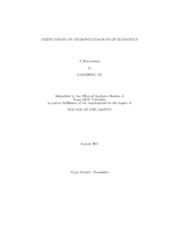| dc.description.abstract | This dissertation, which consists of three essays, studies three applications. Each of them emphasizes the microfoundations of economic models.
The first essay proposes a nonparametric estimation of structural labor supply and exact welfare change under nonconvex piecewise-linear budget sets. Different from previous literature, my method focuses on a nonparametric specification of an indirect utility function. I find that working with the indirect utility function is very
useful in simultaneously addressing the labor supply problems with individual heterogeneity, nonconvex budget sets, labor nonparticipation, and measurement errors
in working hours that previous literature was unable to. Further, the estimated indirect utility function proves to be convenient and efficient in calculating exact welfare change and deadweight loss under general piecewise-linear budget sets.
In the second essay, I solve the equity premium, risk-free rate, and capital structure puzzles by laying a more solid microfoundation for consumption-based asset
pricing models. I argue that the above two asset pricing puzzles arise from the aggregation of hump-shaped life-cycle consumption into per capita consumption, which
accounts for the unanimous rejections of Euler equations in the literature. As for the third puzzle, I show that a firm's capital structure can be determined by heterogenous investors maximizing life-time utility even though the capital structure is irrelevant
on the firm side. The endogenously determined leverage generates an even larger equity premium than a fixed one.
The third essay studies the solution concepts of coalition equilibrium. Traditional solution concepts such as Strong Nash Equilibrium, Coalition-proof Nash Equilibrium, Largest Consistent Set, and Coalition Equilibrium violate the fundamental principles of individual rationality. I define a new solution concept, Weak Coalition Equilibrium, which requires each coalitional deviation to be within-coalition self-enforceable and cross-coalition self-enforceable. The cross-coalition self-enforceability endows coalitions with farsightedness. Weak Coalition Equilibrium is a generalization of Coalition-proof Nash Equilibrium and a re nement of the concept Nash Equilibrium. It exists under a weak condition. Most importantly, it is in line with the
principle of individual rationality. | en |


